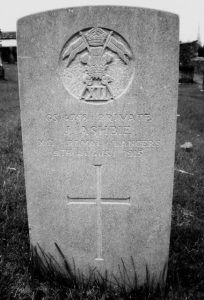FOUR WORLD WAR I GRAVES ST. BRIGID’S CATHEDRAL 1915

WORLD WAR I GRAVES ST. BRIGID’S CATHEDRAL
Mario Corrigan
It came as a bit of a surprise to me some years ago to learn that not all World War I graves marked the death of a soldier killed in action. William Honour of Hospital Street for example who died 6 September 1914 aged 38 and is buried at Grey Abbey may have died at home in Kildare of a kidney infection. So you then imagine that the death at least had to be related to his time in the trenches, that the death was directly related to a wound received or his exposure to war.
In a short period of just over four weeks four men were buried in the grounds of St. Brigid’s Cathedral Kildare: Private John Ashbie, GS/4758, 12th (Prince of Wales’s Royal) Lancers who died on 09 August 1915; Private George Evans, L/4347, 5th (Royal Irish) Lancers who died on 28 August 1915; Private Albert Edward Hughes, 3110, 2nd/1st, Montgomeryshire Yeomanry who died on 06 September 1915; Private Gordon Charles Walker, 3119, 3rd/1st, Montgomeryshire Yeomanry who died on 14 September 1915 Age 21, a son of William and Catherine Walker, of Wrekin House, 15, Wrekin Terrace, St. Michael’s St., Shrewsbury.
Immediately obvious is the fact that two of the men were from the Montgomeryshire Yeomanry and two others in Lancer Regiments. Did they know each other? Had they been at the front? Had they been injured or seen action? For instance the Irish Times of Monday 9 August 1915 reported on 611 wounded who arrived from Le Harve, fifty of whom were taken to the Curragh Camp Hospital. Was there some darker connection – it is a harrowing fact that there appears to be a high percentage of young suicides amongst the British forces stationed in Co. Kildare reported in the local newspapers and the effect that might have on friends and colleagues can only be imagined.
I searched for evidence through the Kildare Observer, Leinster Leader and Irish Times but could only find reference to the death of Private Ashbie in the Observer. There is nothing to be found at this stage concerning the deaths of Privates Evans or Hughes although some material came to light online regarding Private Walker. Genealogical interest has been shown in the death of Private Gordon Charles Walker on the internet and the following information is taken from there. It seems he died of peritonitis or post-operative infection causing a sub-phrenic abscess which occurs below the diaphragm. Therefore it seems he died within 10 days of having an operation, on the 14 September 1915, at the Military Hospital Curragh although the interment record at St. Brigid’s Cathedral mentioned ‘The Barracks, Kildare Town, suggesting he was stationed there. The Montgomeryshire Yeomanry were only recently formed or rather reformed at the outbreak of the war and would not have been long in Kildare. Most sources online say they were stationed at The Curragh. His death was not posted by the family in the local press in Shrewsbury.
But it is the death of Private John Ashbie that raises more questions than answers. The Kildare Observer of 14 August 1915 reported on an inquest at the Military Barracks, Kildare on Tuesday 10 August by Dr. M. F. Kenna, Coroner for South Kildare on the body of John ‘Ashby’, a Private in the 6th reserve Cavalry. John Ashbie’s body was found around 5.45 a.m. at the foot of the stairs leading to his room on the morning of 9 August 1915. Apparently he had gone to bed in good spirits the previous evening and was a well-liked though quiet, peaceable man; he was about 45 years old and married. Two witnesses were examined. John Fleming had slept in the same room but heard no commotion or dispute nor the door being opened. Shoeing-smith Sydney Baxter slept in the room next door but similarly heard no disturbance though he did not see Asbie on the night in question .Baxter remarked that Ashbie was ‘on good terms with everyone in the regiment.’ Dr. E.T. Coady was then examined as he was called to the scene around 6.30 that morning. He found a fracture at the base of the skull caused by his accidentally falling down stairs. There was no other evidence of violence. The jury found in accordance with the medical evidence.
What I found strange was that a man who died of a fall down stairs was listed in official records on the Commonwealth War Graves site as ‘war dead.’ It looks likely that these records simply record all the men who died in World War I but not necessarily just the casualties of war.
originally published for Cill Dara Historical Society in the Kildare Nationalist, 2012
